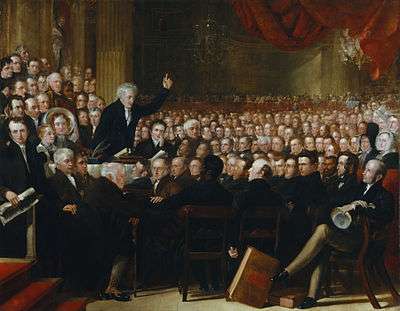Mary Anne Rawson
| Mary Anne Rawson | |
|---|---|
|
Rawson in 1840.[1] | |
| Born |
Mary Anne Read 1801 Sheffield |
| Died | 1887 |
| Residence | Wincobank Hall |
| Nationality | British |
| Occupation | Campaigner |
| Known for | Abolitionism |
| Parent(s) | Joseph and Elizabeth Reid |
Mary Anne Rawson (1801–1887) was an abolitionist. She was a campaigner with the Tract Society, the British and Foreign Bible Society, Italian nationalism, Child labour, but above all anti-slavery. She was first involved with a Sheffield group who successfully campaigned for people to boycott sugar from the West Indies, as it was produced by slave labor.[2] She is pictured attending the World Anti-Slavery Convention in London in 1840.[1]
Biography
Mary Anne Read was born to Joseph and Elizabeth Read, wealthy parents who encouraged her involvement with good causes. Her abiding interest from the mid-1820s to the 1850s was to lead the campaign for anti-slavery in the Sheffield area. Rawson was a founding member in 1825 of the Sheffield Female Anti-Slavery Society, which campaigned for the rights of the slaves in the British Empire.[2] The Sheffield society was the first Anti-Slavery Society to campaign not for a gradual and managed end, but an immediate end to slavery.[3] By lectures and pamphlets, the society successfully boycotted to decrease sales of West Indian goods produced by slaves, such as coffee and sugar. Following passage of the abolition legislation, the society formally ended in 1833.[2]

In 1837 Rawson became secretary of the Sheffield Ladies Association for the Universal Abolition of Slavery,[2] which continued the case for enslaved workers across the world.[2] The anti-slavery organisations run by women were first started by Lucy Townsend and they were sometimes dismissed as of marginal interest, but recent research has revealed that these groups had a national impact.[4]
Rawson corresponded with figures such as George Thompson in Britain as well as Frederick Douglass and William Lloyd Garrison in the United States.[5] Her visitors included Lord Shaftesbury and William Wilberforce.[6] With her mother Elizabeth Read as treasurer, Rawson was prominent in the Sheffield Female Anti-Slavery Society. Her father Joseph Read owned a business involved in the smelting of precious metals.[5]
Her father had built up a business until he was able to buy a substantial house called Wincobank Hall. However his business declined and he was forced to move out of this house. Rawson's father died at the age of 72.

- ^ The Anti-Slavery Society Convention, 1840, Benjamin Robert Haydon, 1841, National Portrait Gallery, London, NPG599, Given by British and Foreign Anti-Slavery Society in 1880
Rawson's early widowhood after her Nottingham banker husband died, allowed her to return and pay off her father's debts. She and her mother retook residence at Wincobank Hall. They both led politically active lives.[7]
The painting shows Rawson in a commemorative painting of the world's first international anti-slavery conference, which attracted delegates from America, France, Haiti, Australia, Ireland, Jamaica and Barbados in 1840.[1] With the exception of Mary Clarkson, all of the women in the painting are shown to the far right and none of them is in the foreground of the painting. No females were allowed into the main body of the convention. This caused some difficulties with the American delegation. Women included in the painting included Elizabeth Pease, Amelia Opie, Baroness Byron, Anne Knight, Mrs John Beaumont, Elizabeth Tredgold, Thomas Clarkson's daughter Mary and right at the back Lucretia Mott. After the convention she played host to Charles Lenox Remond as well as Nathaniel Peabody Rogers.[8]
In 1841, Rawson and her sister, Emily Read, arranged for a day school to be created in the chapel on the grounds of Wincobank Hall. The school was open to local children. In 1860 the sisters created a trust to provide for its financial endowment and management. The school continued until 1905. Today the chapel has been restored for community use.[6]
Publications
In 1834, Rawson compiled a collection of original writings against slavery and in favour of its abolition in the British colonies.[9] The contributions came from fifty writers.[2]
Legacy
The Indiana University's Lilly library has an extensive collection of Rawson's letters and photographs, including a collection of her watercolours of Italy.[10] The University of Sheffield holds a collection of Rawson's materials related to the poet James Montgomery.[11]
References
- 1 2 3
- 1 2 3 4 5 6 Mary Ann Rawson, Museums Sheffield, Retrieved 5 August 2015
- ↑ Women's Anti-Slavery Societies, Spartacus, Retrieved 30 July 2015
- ↑ Clare Midgley, ‘Lloyd , Mary (1795–1865)’, Oxford Dictionary of National Biography, Oxford University Press, 2004; online edn, Sept 2013 accessed 30 July 2015
- 1 2 Women Against Slavery, Clare Midgley, Ebooks Corporation, accessed April 2009
- 1 2 "Upper Wincobank Chapel", Heritage Inspired, accessed April 2009
- ↑ "Wincobank Hall", Sheffield Daily Telegraph, 12 & 14 March 1921, accessed April 2009
- ↑ N.P.Rogers, A Collection from the Miscellaneous Writings of Nathaniel Peabody Rogers, 1949, p. 106, accessed April 2009
- ↑ The Bow in the Cloud; or, the Negro's memorial, Mary Ann Rawson, ed., Jackson & Walford, 1834
- ↑ Rawson Manuscripts, Lilly Library Manuscript Collections, University of Indiana, accessed April 2009
- ↑ "Montgomery Collection", University of Sheffield, accessed April 2009
